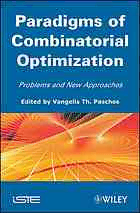Table Of ContentTable of Contents
Preface
PART I Paradigmatic Problems
Chapter 1 Optimal Satisfiability
1.1. Introduction
1.2. Preliminaries
1.3. Complexity of decision problems
1.4. Complexity and approximation of optimization problems
1.5. Particular instances of constraint satisfaction problems
1.6. Satisfiability problems under global constraints
Chapter 2 Scheduling Problems
2.1. Introduction
2.2. New techniques for approximation
2.3. Constraints and scheduling
2.4. Non-regular criteria
2.5. Bibliography
Chapter 3 Location Problems
3.1. Introduction
3.2. Continuous problems
3.3. Discrete problems
3.4. On-line problems
3.5. The quadratic assignment problem
3.6. Conclusion
3.7. Bibliography
Chapter 4 MiniMax Algorithms and Games
4.1. Introduction
4.2. Games of no chance: the simple cases
4.3. The case of complex no chance games
4.4. Quiescence search
4.5. Case of games using chance
4.6. Conclusion
4.7. Bibliography
Chapter 5 Two-dimensional Bin Packing Problems
5.1. Introduction
5.2. Models
5.3. Upper bounds
5.4. Lower bounds
5.5. Exact algorithms
5.6. Acknowledgements
5.7. Bibliography
Chapter 6 The Maximum Cut Problem
6.1. Introduction
6.2. Complexity and polynomial cases
6.3. Applications
6.4. The cut polytope
6.5. Semi-definite programming (SDP) and the maximum cut
problem
6.6. The cut cone and applications
6.7. Approximation methods
6.8. Related problems
6.9. Conclusion
6.10. Bibliography
Chapter 7 The Traveling Salesman Problem and its Variations
7.1. Introduction
7.2. Elementary properties and various subproblems
7.3. Exact solving algorithms
7.4. Approximation algorithm for max TSP
7.5. Approximation algorithm for min TSP
7.6. Constructive algorithms
7.7. Conclusion
7.8. Bibliography
Chapter 8 0–1 Knapsack Problems
8.1. General solution principle
8.2. Relaxation
8.3. Heuristic
8.4. Variable fixing
8.5. Dynamic programming
8.6. Solution search by hybridization of branch-and-bound
and dynamic programming
8.7. Conclusion
8.8. Bibliography
Chapter 9 Integer Quadratic Knapsack Problems
9.1. Introduction
9.2. Solution methods
9.3. Numerical experiments
9.4. Conclusion
9.5. Bibliography
Chapter 10 Graph Coloring Problems
10.1. Basic notions of colorings
10.2. Complexity of coloring
10.3. Sequential methods of coloring
10.4. An exact coloring algorithm
10.5. Tabu search
10.6. Perfect graphs
10.7. Chromatic scheduling
10.8. Interval coloring
10.9. T-colorings
10.10. List colorings
10.11. Coloring with cardinality constraints
10.12. Other extensions
10.13. Edge coloring
10.14. Conclusion
10.15. Bibliography
PART II New Approaches
Chapter 11 Polynomial Approximation
11.1. What is polynomial approximation?
11.2. Some first examples of analysis: constant approximation
ratios
11.3. Approximation schemes
11.4. Analyses depending on the instance
11.5. Conclusion: methods and issues of approximation
11.6. Bibliography
Chapter 12 Approximation Preserving Reductions
12.1. Introduction
12.2. Strict and continuous reductions
12.3. AP-reduction and completeness in the classes NPO and
APX
12.4. L-reduction and completeness in the classes Max-SNP
and APX …
12.5. Affine reduction
12.6. A few words on GAP-reduction
12.7. History and comment
12.8. Bibliography
Chapter 13 Inapproximability of Combinatorial Optimization
Problems
13.1. Introduction
13.2. Some technical preliminaries
13.3. Probabilistically checkable proofs
13.4. Basic reductions
13.5. Optimized reductions and PCP constructions
13.6. An overview of known inapproximability results
13.7. Integrality gap results
13.8. Other topics
13.9. Conclusions
13.10. Prove optimal results for 2-query PCPs
13.11. Settle the Unique Games Conjecture
13.12. Prove a strong inapproximability result for Metric TSP
13.13. Acknowledgements
13.14. Bibliography
Chapter 14 Local Search: Complexity and Approximation
14.1. Introduction
14.2. Formal framework
14.3. A few familiar optimization problems and their
neighborhoods
14.4. The PLS class
14.5. Complexity of the standard local search algorithm
14.6. The quality of local optima
14.7. Approximation results
14.8. Conclusion and open problems
14.9. Bibliography
Chapter 15 On-line Algorithms
15.1. Introduction
15.2. Some classical on-line problem
15.3. Competitive analysis of deterministic algorithms
15.4. Randomization
15.5. Extensions of competitive analysis
15.6. Bibliography
Chapter 16 Polynomial Approximation for Multicriteria
Combinatorial Optimization Problems
16.1. Introduction
16.2. Presentation of multicriteria combinatorial problems
16.3. Polynomial approximation and performance guarantee
16.4. Bibliographical notes
16.5. Conclusion
16.6. Bibliography
Chapter 17 An Introduction to Inverse Combinatorial
Problems
17.1. Introduction
17.2. Definitions and notation
17.3. Polynomial inverse problems and solution techniques
17.4. Hard inverse problems
17.5. Conclusion
17.6. Bibliography
Chapter 18 Probabilistic Combinatorial Optimization
18.1. Motivations and applications
18.2. The issues: formalism and methodology
18.3. Problem complexity
18.4. Solving problems
18.5. Approximation
18.6. Bibliography
Chapter 19 Robust Shortest Path Problems
19.1. Introduction
19.2. Taking uncertainty into account: the various models
19.3. Measures of robustness
19.4. Complexity and solution of robust shortest path
problems in the interval mode
19.5. Complexity and solution of robust shortest path
problems in a discrete set of scenarios model
19.6. Conclusion
19.7. Bibliography
Chapter 20 Algorithmic Games
20.1. Preliminaries
20.2. Nash equilibria
20.3. Mixed extension of a game and Nash equilibria
20.4. Algorithmic problems
20.5. Potential games
20.6. Congestion games
20.7. Final notes
20.8. Bibliography
Chapter 21 Combinatorial Optimization with Competing
Agents
21.1. Introduction
21.2. Social welfare optimization in Social Networks
21.3. A simple connection game
21.4. Efficiency of truthful algorithms without payment
21.5. Bibliography
General Bibliography
List of Authors
Index
Summary of Volume 1 Concepts of Combinatorial
Optimization

